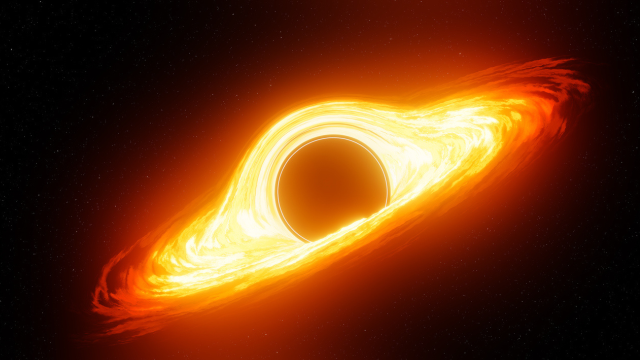Light famously cannot escape the event horizon of a black hole, leaving astrophysicists to theorize and speculate what it’s like beyond the limits of human perception. Now, NASA researchers take that theorization a step further, in the form of an animation that takes you (the viewer) into the black hole.
Black holes are some of the densest objects in the universe. Light cannot escape their event horizons because the holes’ gravitational pull is so intense. At the limit of the black hole is its accretion disk—that bright orange-yellow swirl of superheated material that the black hole has pulled to its vicinity. Occasionally, bits of the accretion disk fall into the black hole, causing visible flare-ups that astronomers can observe and document.
Your first view into the imagined centre of a black hole may have been the climactic scene in Interstellar, when Matt McConaughey’s character plunges into the inky black yonder. The new animation doesn’t feature any Hollywood stars; its main character is a supermassive black hole, 4.3 million times the mass of the Sun.
“I simulated two different scenarios, one where a camera—a stand-in for a daring astronaut—just misses the event horizon and slingshots back out, and one where it crosses the boundary, sealing its fate,” said Jeremy Schnittman, an astrophysicist at NASA’s Goddard Space Flight Center, in an agency release.
Though we can image black holes—the Event Horizon Telescope first observed one’s shadow in 2019, and followed that up with an image of the black hole at the center of our own galaxy in 2022—they are very hard to image, so computer simulations offer astrophysicists a better view of the complicated physics that occur as you approach such a gravitational behemoth.

According to the release, an ordinary laptop would’ve taken over a decade to render the animation, but NASA Goddard’s Discover supercomputer completed the task in five days, using just 0.3% of its processing power.
The visualization begins with the camera about 400 million miles from the black hole, the release noted, and as the viewer approaches the object, everything in view gets increasingly distorted as spacetime is warped by the black hole. Once it crosses over, it is stretched into oblivion—or spaghettified—in less than 13 seconds, Schnittman said.
Set to Thomas Daniel Bellingham’s “Tidal Force,” Digital Juice’s “Memories,” and Eric Jacobson and Lorenzo Castellarin’s “Path Finder,” the music meets the moment. The tunes sound like if Daft Punk, Hans Zimmer, and the composers of Runescape’s soundtrack got together for a last dance.
The release added that from the point of spaghettification, the viewer only has to travel 79,500 miles (128,000 kilometers) to reach the singularity at the center of the black hole, a voyage through the black hole that occurs almost instantaneously.
Watch below:
Image: iStock
